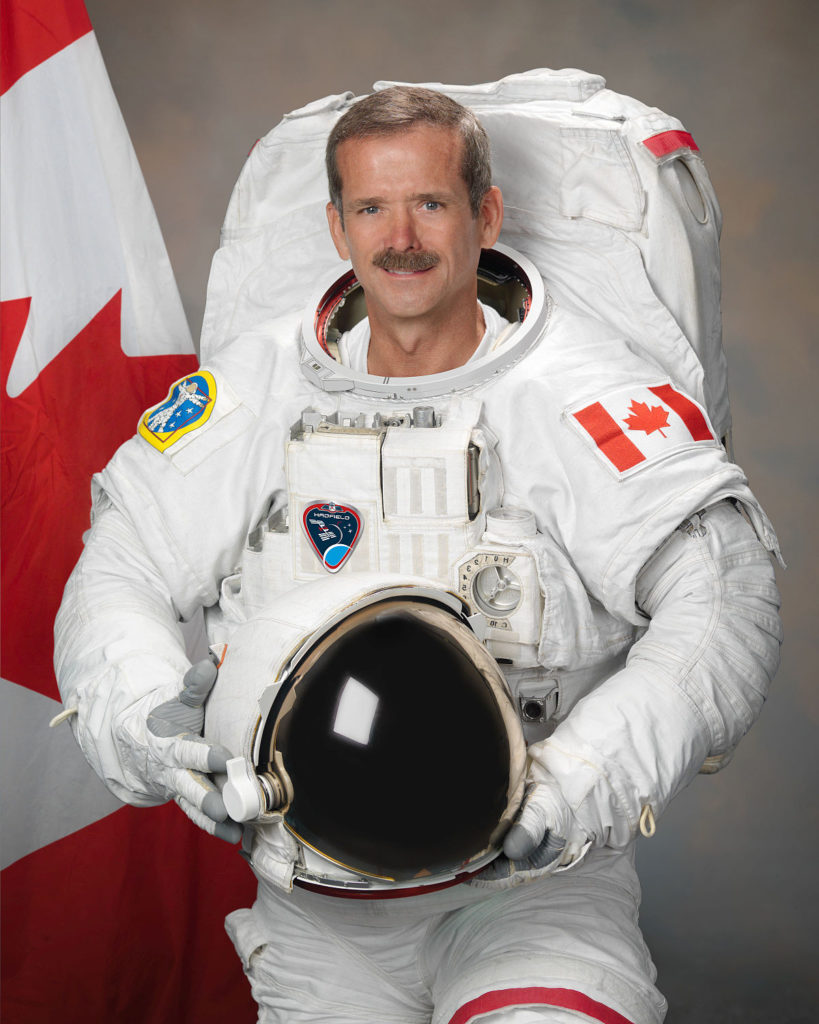Scroll down for printables.

Imagine being in space
Imagine zipping around Earth in the International Space Station, seeing a new sunrise every 90 minutes. While orbiting you’re weightless, so instead of walking you fly and float. Right outside the Space Station there is no air and no pressure. In the sun it’s extremely hot: 250 degrees Fahrenheit or higher. In the dark it’s immensely cold: minus 150 degrees.
Now imagine a marshmallow inside the Space Station. If not secured, it will float. Take the same marshmallow outside on a spacewalk, and because there are air pockets trapped inside, it will swell. In the sun it will become a gooey mass; in the dark it will freeze and become a snowball. Indeed, life is very different in space than it is on Earth!
Who is Colonel Chris Hadfield?
Colonel Chris Austin Hadfield was born on August 29, 1959, in Sarnia, Ontario, Canada, and grew up on a corn farm in Milton, near Toronto. Since the age of nine, after seeing the first moon landing on television, Hadfield dreamed of becoming an astronaut. Canada had no astronaut program, but Hadfield was determined. He spent his time learning mechanics on tractors and old cars, and on flying with his father, an airline pilot, and brothers whenever he could.
Hadfield entered aviation with the Royal Canadian Air Cadets at age 13, won a glider pilot scholarship at age 15, and a powered pilot scholarship one year later. After graduating from high school, Hadfield decided to “bum around” Europe for six months, living frugally as a ski instructor.
Hadfield joined the Canadian Armed Forces in 1978 and then attended military colleges in Canada. He graduated in 1982 with a bachelor’s degree in mechanical engineering. After training as a fighter pilot, he flew planes for the North American Aerospace Defence Command (NORAD).
Pilot of the year!
Hadfield next transitioned to test-pilot training and was stationed in Maryland, where he flew fighter jets. By the early 1990s, Hadfield had flown more than 70 different kinds of aircraft, and was named the U.S. Navy test pilot of the year in 1991. He received a master’s degree in aviation systems in 1992 from the University of Tennessee. That same year Hadfield reached his dream when the Canadian Space Agency (CSA) selected him as an astronaut, a profession from which he retired in 2013.
Calling Houston
In 2001, Hadfield was working outside the International Space Station on his first spacewalk when he was struck blind due to the anti-fog solution used to polish his spacesuit visor. He eventually called down to Houston for assistance, and with their help he could start to see again. Hadfield told Houston, “I’m OK,” and got back to work.
Whether your dream is to become a doctor, lawyer, teacher, professional athlete, or astronaut, it is imperative that you, like Col. Chris Hadfield once did, dream big and reach for the stars!
.
.
.
.
Lunch inside the Space Station
.
Questions:
- Find the synonym for circling in the passage.
- Find two synonyms for extraordinary in the passage.
- Do you know what a spacewalk is?
- Find the antonym for shrink in the passage.
- In what year was Hadfield born?
- In what country?
- Find a word in the passage that fits the following definition: “Having a strong feeling that you are going to do something and that you will not allow anyone or anything to stop you.”
- How old was Hadfield when he joined the Royal Canadian Air Cadets?
- How old was he when he won a glider pilot scholarship?
- Do you know what frugally means?
- Can you think of a synonym?
- In what year was Hadfield named the U.S. Navy test pilot of the year?
- What is the abbreviation for North American Aerospace Defence Command?
- What does CSA stand for?
- What does profession mean?
- What does retired mean?
- For how many decades was Hadfield an astronaut?
- What caused Hadfield to become temporary blind during his first spacewalk?
- He called Houston for help. Who or where is Houston?
- Find the synonym for “very important” in the passage.
- Do you have dreams for the future? What are your dreams?
.
.
Answers:
- Orbiting
- Extremely and immensely
- Any time an astronaut gets out of a space vehicle is called a spacewalk.
- Swell
- 1959
- Canada
- Determined
- 13
- 15
- Being careful about spending money.
- Sparingly
- 1991
- NORAD
- Canadian Space Agency
- A type of job that requires special education, training, or skill.
- Not working anymore; having ended your professional career.
- Two (a decade = 10 years).
- The anti-fog solution used to polish his spacesuit visor.
- Houston is in Texas. Hadfield was calling the Johnson Space Center in Houston for help.
- Imperative
- …
.
.
Printables:
Comprehension worksheet – passage only
Comprehension worksheet – questions and answers only
Comprehension worksheet with questions and answers per paragraph
.
Edublox offers cognitive training and live online tutoring to students with dyslexia, dysgraphia, dyscalculia, and other learning disabilities. Our students are in the United States, Canada, Australia, and elsewhere. Book a free consultation to discuss your child’s learning needs.

